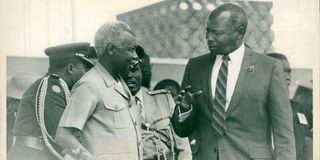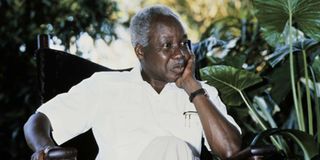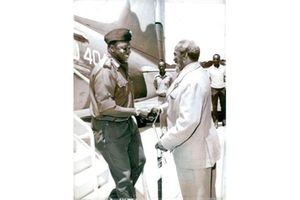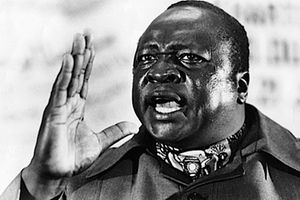
Former Tanzanian president Julius Nyerere (left) and his Kenyan counterpart Daniel arap Moi.
The relationship between Mwalimu Julius Nyerere and Daniel arap Moi had deteriorated so badly in the late 1970s during the military operation to overthrow Ugandan dictator Idi Amin that the Tanzanian President had to go through the Americans to pass an urgent message to his Kenyan counterpart, recently released documents reveal.
Mwalimu Nyerere, whose forces had invaded Uganda to depose dictator Idi Amin in 1979, desperately wanted Kenya to cooperate by cutting off oil supply to Uganda which would then incapacitate Amin’s military.

Former Ugandan president Idi Amin Dada.
Amin’s soldiers had just secured a slight victory against the invading Tanzanian forces at Tororo in March 1979. Buoyed by this development, Amin sought further assistance from his Arab allies, who responded in kind by sending him more fighters and military hardware. Yasser Arafat sent 40 Palestinian fighters to join 140 who were already embedded in the Ugandan Army while Muammar Gaddafi sent 1,000 Libyan soldiers. The Libyan leader also sent to Uganda 12 armoured personnel carriers, Land Rovers equipped with 106 mm recoilless rifles, 12 Katyusha rocket launchers and 15 T-55 tanks.
Spooked by the turn of events, on March 10,1979, Mwalimu Nyerere summoned James Spain, the then US Ambassador to Tanzania, and asked him whether US could convince Kenya to help in the mission. Ambassador Spain promised to pass on the request to his seniors at the US State Department in Washington. On that same day, the US State Department confirmed in a telegram number 1124 the receipt of the message from Dar es Salaam.
However, before taking any step to contact President Moi on behalf of Mwalimu Nyerere, the State Department first sought to know from Wilbert Le Melle, the then US ambassador to Kenya, what his thoughts were about Nairobi’s attitude towards the Uganda-Tanzania conflict. Kenya was opposed to the invasion out of fear that Mwalimu Nyerere wanted to occupy Uganda, which was a key market for Kenyan goods and also to return Apollo Milton Obote to power. Based on this and many other reasons, Le Melle notified Washington in a Telegram dated March 11, that President Moi was unlikely to intervene in Uganda but there was a possibility that he could be influenced to have a conversation with the Tanzanian President.

Former Tanzanian president Julius Nyerere (left) and his Kenyan counterpart Daniel arap Moi.
Following this assessment by Le Melle in Nairobi, the US State Department notified the US Ambassador in Dar es Salaam to inform Mwalimu Nyerere that they were ready to talk to President Moi on his behalf. However, the diplomat was also to make it known to the Tanzania leader that the US would not raise with Moi all the issues he wanted or give a guarantee that Kenya would cooperate in the Ugandan situation the way he desired. This information was delivered to Mwalimu Nyerere in Dar es Salaam on March 13 by US Ambassador Spain. During the meeting, a draft of the message the US was to deliver to Moi following Mwalimu Nyerere’s request was also shared by the Americans.
“President Nyerere told Ambassador Spain in Dar es Salaam that he believes it would be useful to have a discreet discussion with you on ways in which your two governments might cooperate to resolve the Ugandan situation. Nyerere asked Spain if the US would be willing to relay this message in the interest of bringing an early end to the Tanzania-Uganda conflict,” the draft read.
It continued: “We agreed to do so for that reason, but as you are aware we have tried not to become involved in this dispute and have hoped that an African solution could be reached. If you desire to talk to Nyerere about Uganda, we assume you will wish to arrange that through your own channels. If you desire, we will also advise Ambassador Spain to tell President Nyerere that you are interested in talking with Nyerere about Uganda and will welcome a direct communication from him.”
The draft note intended for President Moi concluded: “We feel strongly that events going on in East Africa and communication between African leaders is an African matter in which we do not believe we can appropriately be involved.”
Mwalimu Nyerere was told that if the message appeared satisfactory to him then the US would go ahead to deliver it to Moi. Even though the officials were prepared to make some modifications to the message depending on the Tanzanian President’s suggestion, they were not ready to make changes that implicated the US in the situation.
“We are willing of course to accept minor modifications by Nyerere to our proposed representation to Moi, but we could not accept amendments which would tend to involve us any more directly in this matter,” Christopher Warren Minor, US deputy secretary of State advised US Ambassador in Dar es Salaam.
With Mwalimu Nyerere satisfied, the final message was delivered to President Moi at State House Nairobi by Ambassador Le Melle, the US Ambassador to Kenya, on April 3, 1979. The diplomat also had a special message from President Jimmy Carter to President Moi requesting Kenya not to allow Libyan war material to transit through Kenya. President Moi responded that he “would do what he could.” Just after the meeting, the Kenyan president had his first telephone conversation with Mwalimu Nyerere after a very long time.

Former Tanzanian President Julius Nyerere in Dar es Salam, Tanzania on January 31, 1985. File | Nation Media Group
That same day President Moi banned the selling of petroleum to Uganda and the refuelling of Libyan aircraft to and from Uganda. Without fuel, Amin couldn’t sustain a mechanised military assault against the invading Tanzanians. The following day, April 4, 1979, Mwalimu Nyerere summoned ambassador James Spain and told him to thank President Carter. The Tanzanian leader credited Carter’s message for Moi’s cooperation in the conflict.
Describing his talk with Moi as productive, Mwalimu Nyerere also said he would try to alleviate some concerns raised by the Kenyan Head of State during the telephone conversation. President Moi was particularly concerned about the possibility of Milton Obote who was in exile in Dar es Salaam, after being overthrown by Amin in 1971, finding his way back to power with the help of Tanzanians and “imposing his will on the Ugandans”. Mwalimu Nyerere once again thanked the diplomat, telling him that he would find time to personally thank President Carter.
“Nyerere told our Charge in Dar es Salaam this morning that he credited your message to Moi for the increased cooperation Moi pledged. He said he was deeply grateful and would find an occasion soon to thank you properly,” US Secretary of State Cyrus Vance informed President Carter on April 4,1979.
This was happening as Tanzania soldiers and Ugandan rebels launched a major assault on Kampala, killing many Libyan and Palestinian fighters before capturing the city on April 10,1979 as Amin fled to exile. After a short transitional period, Obote with the support of Mwalimu Nyerere, returned to power just as Moi had feared.
As a result, the Moi/Nyerere relationship that was on the mend following President Carter’s intercession deteriorated further. Apart from President Moi’s long-held suspicion against Obote, he was also not happy with the continued presence of Tanzanian soldiers in Uganda. He believed that Nyerere was using his great influence on Obote to isolate Kenya from Uganda, which was a key trading partner.


